C++ AVLTree高度平衡的二叉搜索树怎么实现
这篇“C++ AVLTree高度平衡的二叉搜索树怎么实现”文章的知识点大部分人都不太理解,所以小编给大家总结了以下内容,内容详细,步骤清晰,具有一定的借鉴价值,希望大家阅读完这篇文章能有所收获,下面我们一起来看看这篇“C++ AVLTree高度平衡的二叉搜索树怎么实现”文章吧。
一、AVL树的概念
二叉搜索树虽可以缩短查找的效率,但如果数据有序或接近有序二叉搜索树将退化为单支树,查找元素相当于在顺序表中搜索元素,效率低下。
因此,两位俄罗斯的数学家G.M.Adelson-Velskii和E.M.Landis在1962年发明了一种解决上述问题的方法:当向二叉搜索树中插入新结点后,如果能保证每个结点的左右子树高度之差的绝对值不超过1(需要对树中的结点进行调整),即可降低树的高度,从而减少平均搜索长度。
一棵AVL树或者是空树,或者是具有以下性质的二叉搜索树:
它的左右子树都是AVL树
左右子树高度之差(简称平衡因子)的绝对值不超过1(-1/0/1)
平衡因子= 右子树高度-左子树高度

如果一棵二叉搜索树是高度平衡的,它就是AVL树。如果它有n个结点,其高度可保持在O(log2N) ,搜索时间复杂度O(log2N)
二、AVL树节点的定义
节点结构:三叉链结构(左、右、父),以及平衡因子bf+构造函数(左右为空,平衡因子初始化为0)
template<class K,class V>struct AVLTreeNode{pair<K, V> _kv;AVLTreeNode<K, V>* _left;AVLTreeNode<K, V>* _right;AVLTreeNode<K, V>* _parent;int _bf;//balance factorAVLTreeNode(const pair<K,V>&kv):_kv(kv),_left(nullptr),_right(nullptr),_parent(nullptr),_bf(0){}};三、AVL树的插入
AVL树在二叉搜索树的基础上引入了平衡因子,因此AVL树也可以看成是二叉搜索树。步骤过程:
找到插入的位置:根据二叉搜索树的做法
进行插入:判断插入的位置是parent的左还是右
更新平衡因子:如果不平衡的话,就要进行旋转
找到插入位置(比较节点大小即可):
插入的节点key值
>当前位置的key值,往右子树走插入的节点key值
<当前位置的key值,往左子树走插入的节点key值等于当前位置的key值,不能插入,返回false
插入之后,与二叉搜索树不同的是:我们还需要去进行平衡因子的更新,调平衡:
如果新增加的在右,平衡因子加加
如果新增加的在左,平衡因子减减
更新一个结点之后我们需要去进行判断,子树的高度是否发生了变化:
如果parent的平衡因子是0:说明之前parent的平衡因子是1或-1,说明之前parent一边高、一边低;这次插入之后填入矮的那边,parent所在的子树高度不变,不需要继续往上更新
如果parent的平衡因子是1或者-1:说明之前parent的平衡因子是0,两边一样高,插入之后一边更高,parent所在的子树高度发生变化,继续往上更新
平衡因子是2或-2,说明之前parent的平衡因子是1或-1,现在插入严重不平衡,违反规则,需要进行旋转处理
最坏的情况下:需要一直更新到根root:
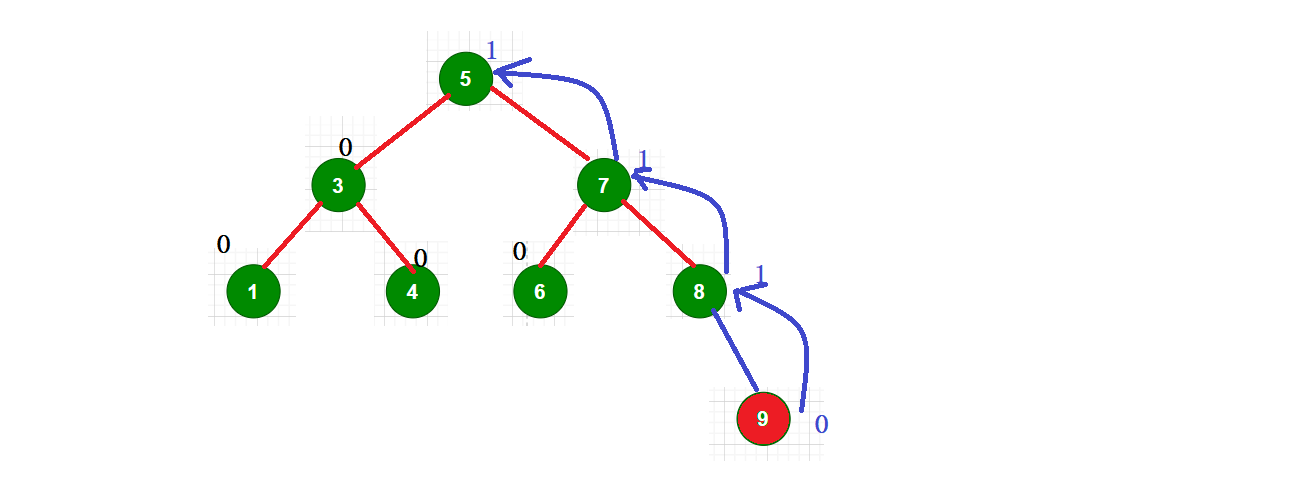
我们更新平衡因子时第一个更新的就是parent,如果parent->_bf1或parent->_bf-1需要继续往上进行平衡因子的更新,向上迭代,直到parent为空的情况:
else if (parent->_bf == 1 || parent->_bf == -1){ cur = parent; parent = parent->_parent;}当parent->_bf = 2或parent->_bf==-2时,我们就需要进行旋转了:
????如果parent的平衡因子是2,cur的平衡因子是1时,说明右边的右边比较高,我们需要进行左单旋
????如果parent的平衡因子是-2,cur的平衡因子是-1时,说明左边的左边比较高,我们需要进行右单旋
????如果parent的平衡因子是-2,cur的平衡因子是1时,我们需要进行左右双旋
????如果parent的平衡因子是2,cur的平衡因子是-1时,我们需要进行右左双旋
bool Insert(const pair<K, V>& kv){if (_root == nullptr){_root = new Node(kv);return true;}Node* parent = nullptr;Node* cur = _root;while (cur){if (cur->_kv.first < kv.first){parent = cur;cur = cur->_right;}else if (cur->_kv.first > kv.first){parent = cur;cur = cur->_left;}else{return false;}}cur = new Node(kv);if (parent->_kv.first < kv.first){parent->_right = cur;cur->_parent = parent;}else{parent->_left = cur;cur->_parent = parent;}//更新平衡因子while (parent){if (cur == parent->_left){parent->_bf--;}else{parent->_bf++;}if (parent->_bf == 0){break;}else if (parent->_bf == 1 || parent->_bf == -1){cur = parent;parent = parent->_parent;}else if(parent->_bf==2||parent->_bf==-2){//左旋转if (parent->_bf == 2 && cur->_bf == 1){RotateL(parent);}//右旋else if (parent->_bf == -2 && cur->_bf == -1){RotateR(parent);}//左右双旋else if (parent-> _bf == -2&&cur->_bf==1){RotateLR(parent);}//右左双旋else if (parent->_bf ==2&&cur->_bf ==-1){RotateRL(parent);}else{assert(false);}break;}else{assert(false);}}return true;}四、AVL树的旋转
在一棵原本是平衡的AVL树中插入一个新节点,可能造成不平衡,此时必须调整树的结构,使之平衡化。根据节点插入位置的不同,AVL树的旋转分为四种。
旋转规则:
让这颗子树左右高度差不超过1
旋转过程中继续保持它是搜索树
更新调整孩子节点的平衡因子
让这颗子树的高度根插入前保持一致
1.左单旋
新节点插入较高右子树的右侧—右右:左单旋
抽象图:

a/b/c是高度为h的AVL子树,代表多数情况:h>=0,其中h可以等于0、1、2…,不过都可以抽象成h,处理情况都一样:此时parent等于2,subR等于1。
具体左旋的步骤:
subRL成为parent的右子树:注意subL和parent的关系,调整parent的右以及subRL的父(subRL可能为空)
parent成为subR的左子树:调整parent的父与subR的左
subR成为相对的根节点:调整subR与ppNode:注意parent是不是整棵树的root,如果是,则让subR为_root,同时让_root->_parent置为空
更新平衡因子
左旋调整:subR的左子树值(subRL)本身就比parent的值要大,所以可以作为parent的右子树;而parent及其左子树当中结点的值本身就比subR的值小,所以可以作为subR的左子树。
**更新平衡因子bf:**subR与parent的bf都更新为0
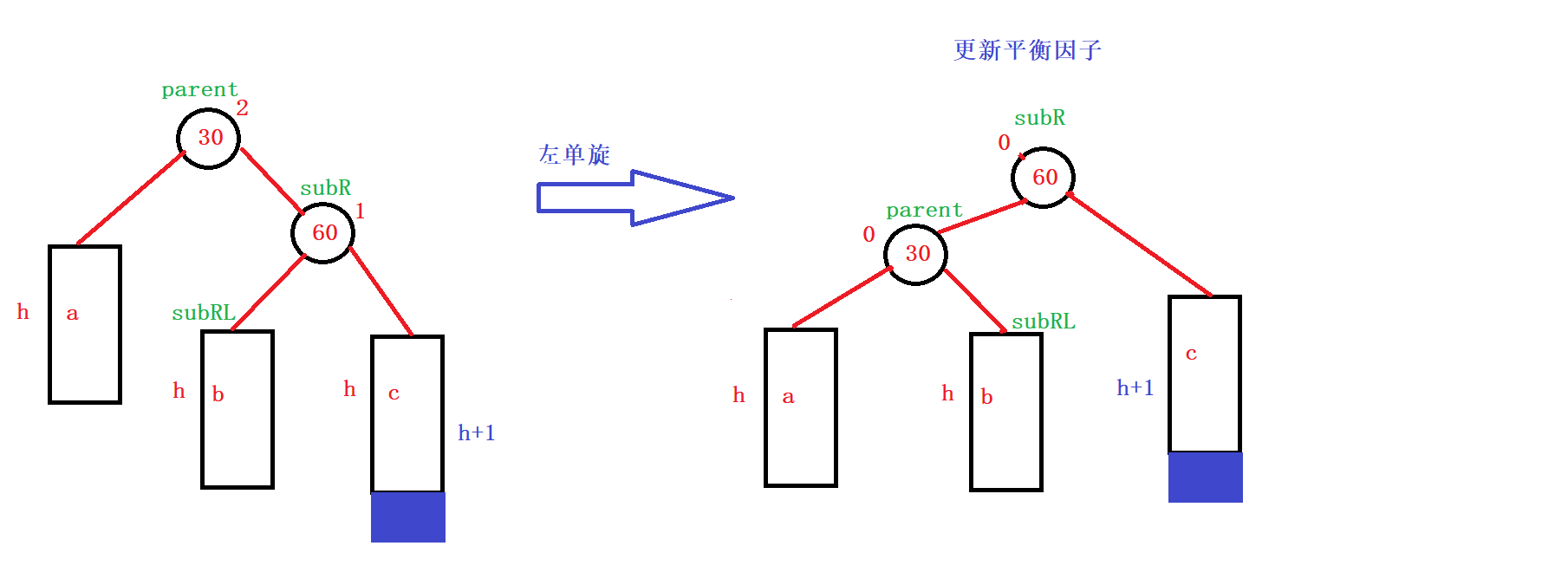
代码实现左旋转:
//左单旋void RotateL(Node* parent){Node* subR = parent->_right;Node* subRL = subR->_left;parent->_right = subRL;if (subRL)subRL->_parent = parent;Node* ppNode = parent->_parent;subR->_left = parent;parent->_parent = subR;if (ppNode == nullptr){_root = subR;_root->_parent = nullptr;}else{if (ppNode->_left == parent){ppNode->_left = subR;}else{ppNode->_right = subR;}subR->_parent = ppNode;}parent->_bf = subR->_bf = 0;}2.右单旋
新节点插入较高左子树的左侧—左左:右单旋
有了前面左旋的基础,我们在来看右旋就没有那么费劲了:
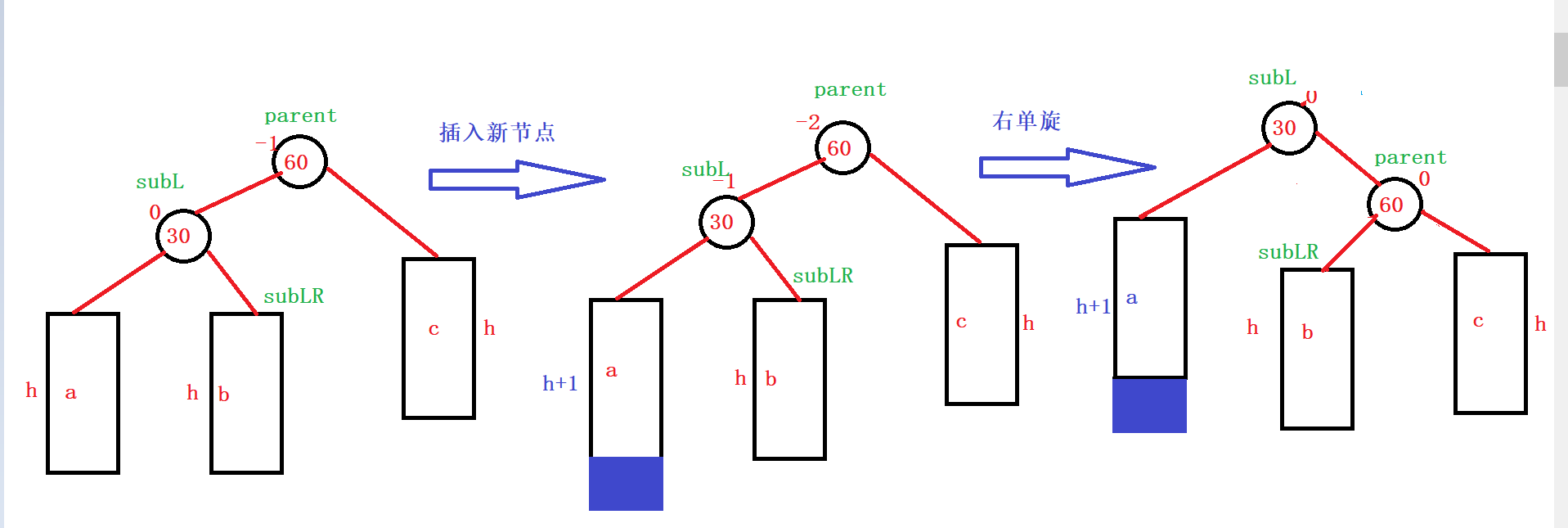
a/b/c是高度为h的AVL树,右旋旋转动作:b变成60的左边,60变成30的右边,30变成子树的根。
30比60小,b值是处于30和60之间,此时作为60的左边是没有问题的。
有了这个图,在结合前面左单旋的基础,我们就能很快实现我们的右单旋代码:
//右单旋void RotateR(Node* parent){Node* subL = parent->_left;Node* subLR = subL->_right;parent->_left = subLR;if (subLR)subLR->_parent = parent;Node* ppNode = parent->_parent;parent->_parent = subL;subL->_right = parent;//if(_root==parent)if (ppNode == nullptr){_root = subL;_root->_parent = nullptr;}else{if (ppNode->_left == parent){ppNode->_left = subL;}else{ppNode->_right = subL;}subL->_parent = ppNode;}subL->_bf = parent->_bf = 0;}3.左右双旋
新节点插入较高左子树的右侧—左右:先左单旋再右单旋
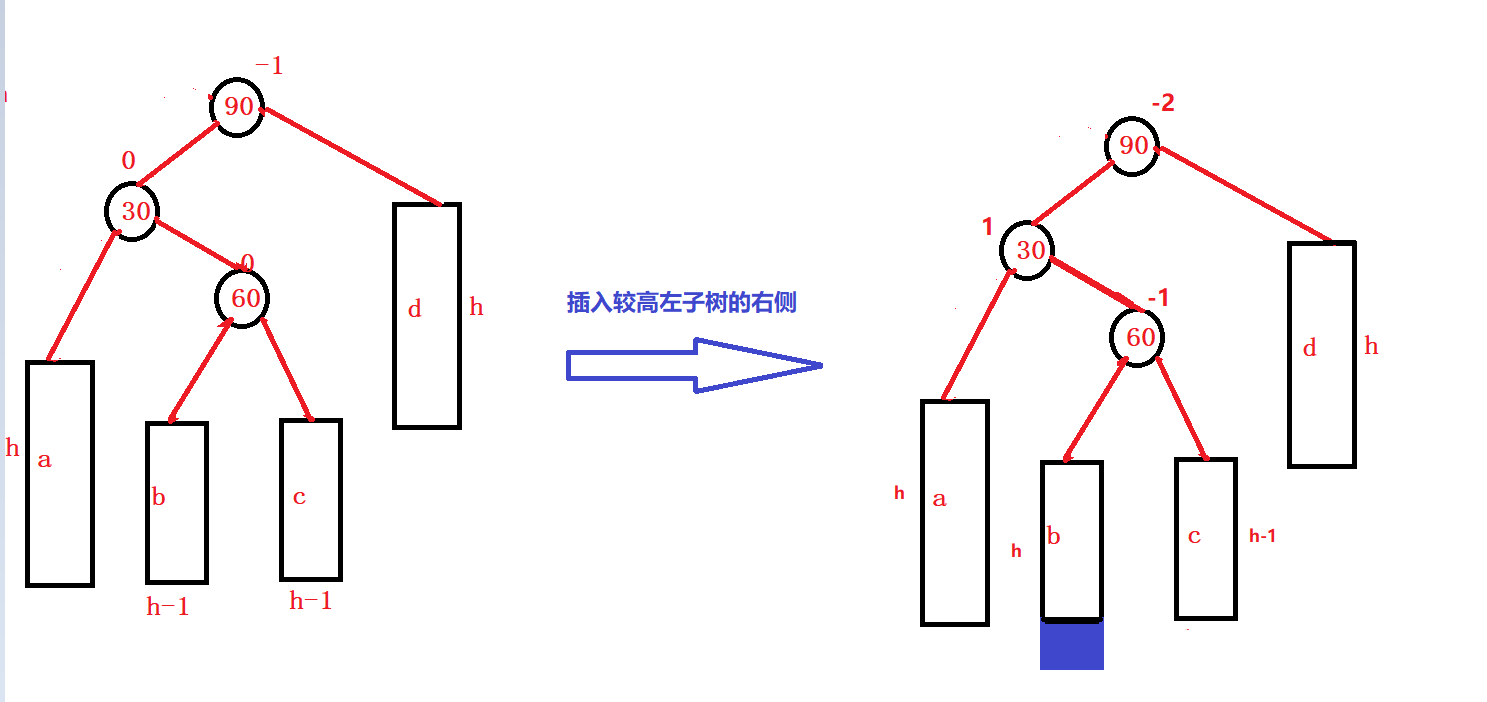
a/d是高度为h的AVL树,b/c是高度为h-1的AVL树。
以30为轴点进行左单旋:b变成30的右边,30变成60的左边,60变成子树根
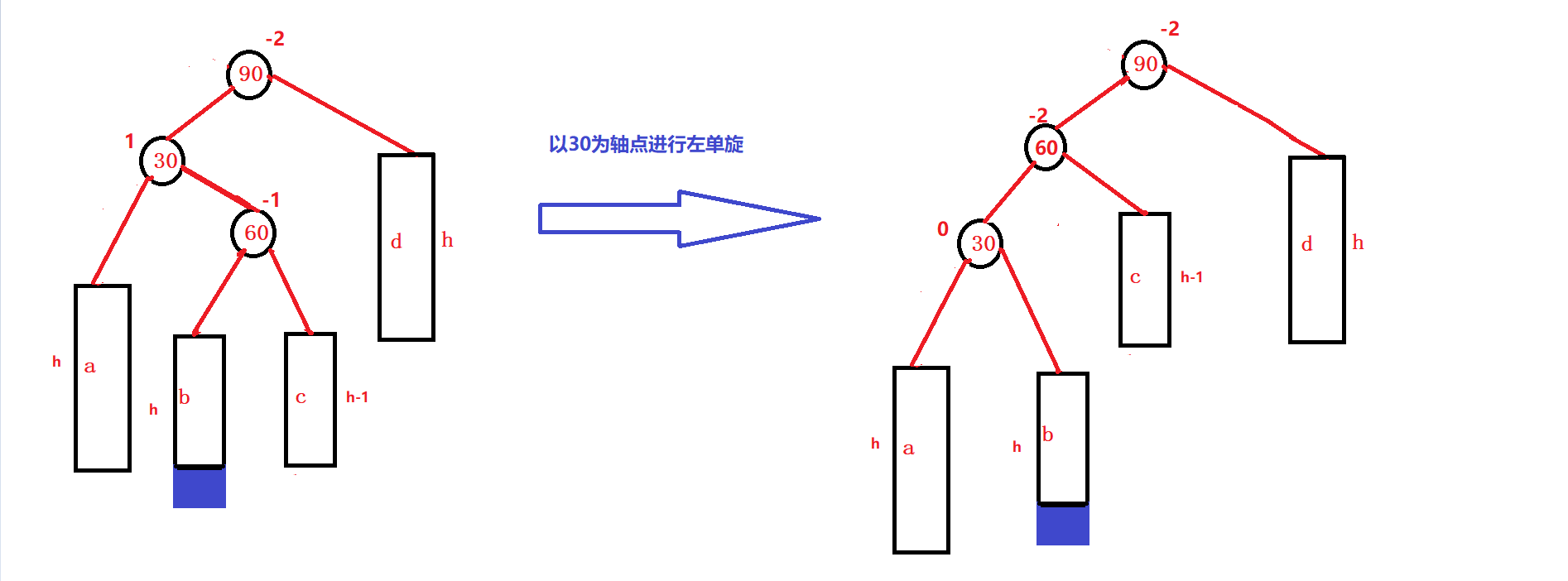
以90为轴点进行右单旋:c变成90的左边,90变成60的右边,60变成子树的根
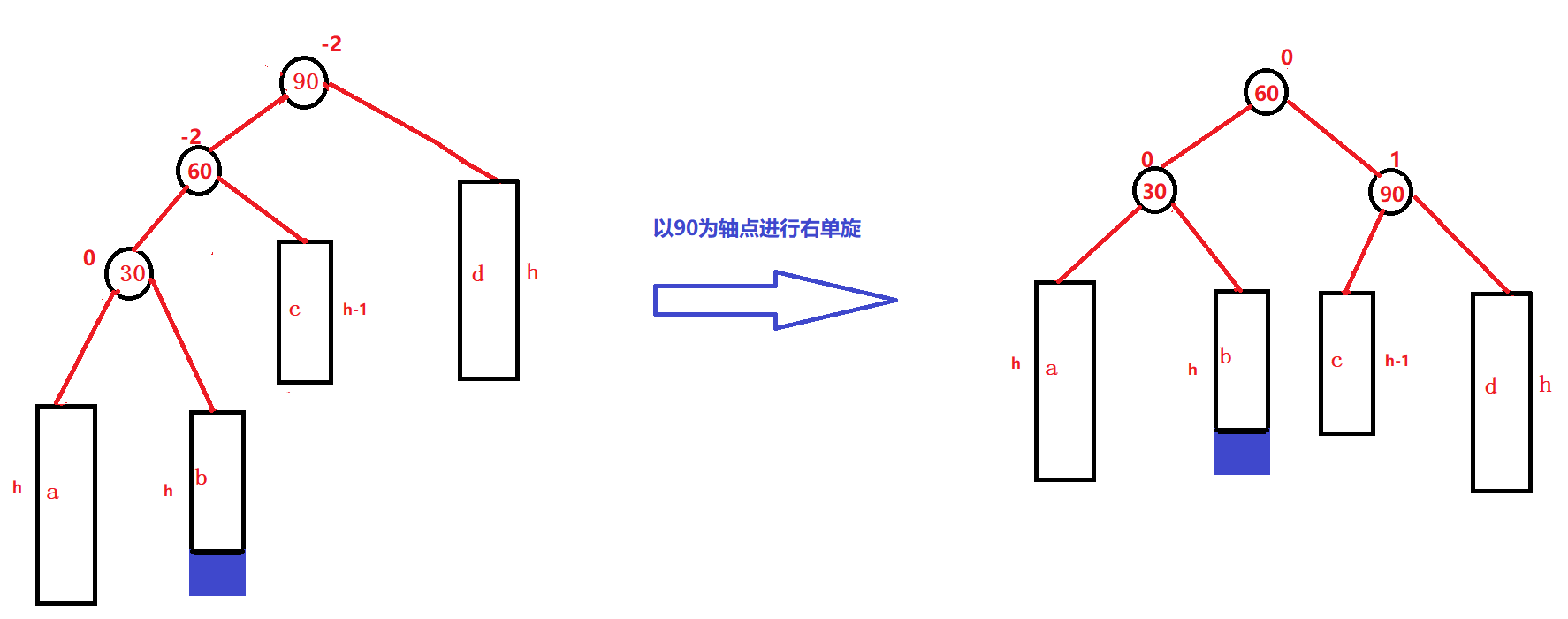
左右双旋:以subL为轴点左旋,以parent为轴点进行右旋,在进行平衡因子的更新(最大的问题)
我们从总体的角度来看,左右双旋的结果就是:就是把subLR的左子树和右子树,分别作为subL和parent的右子树和左子树,同时subL和parent分别作为subLR的左右子树,最后让subLR作为整个子树的根
subLR的左子树作为subL的右子树:因为subLR的左子树结点比subL的大
subLR的右子树作为parent的左子树:因为subLR的右子树结点比parent的小
平衡因子的更新:重新判断(识别插入节点是在b还是在c)根据subLR平衡因子的初始情况进行分类:
如果subLR初始平衡因子是-1时,左右双旋后parent、subL、subLR的平衡因子分别更新为1、0、0(插入在b)
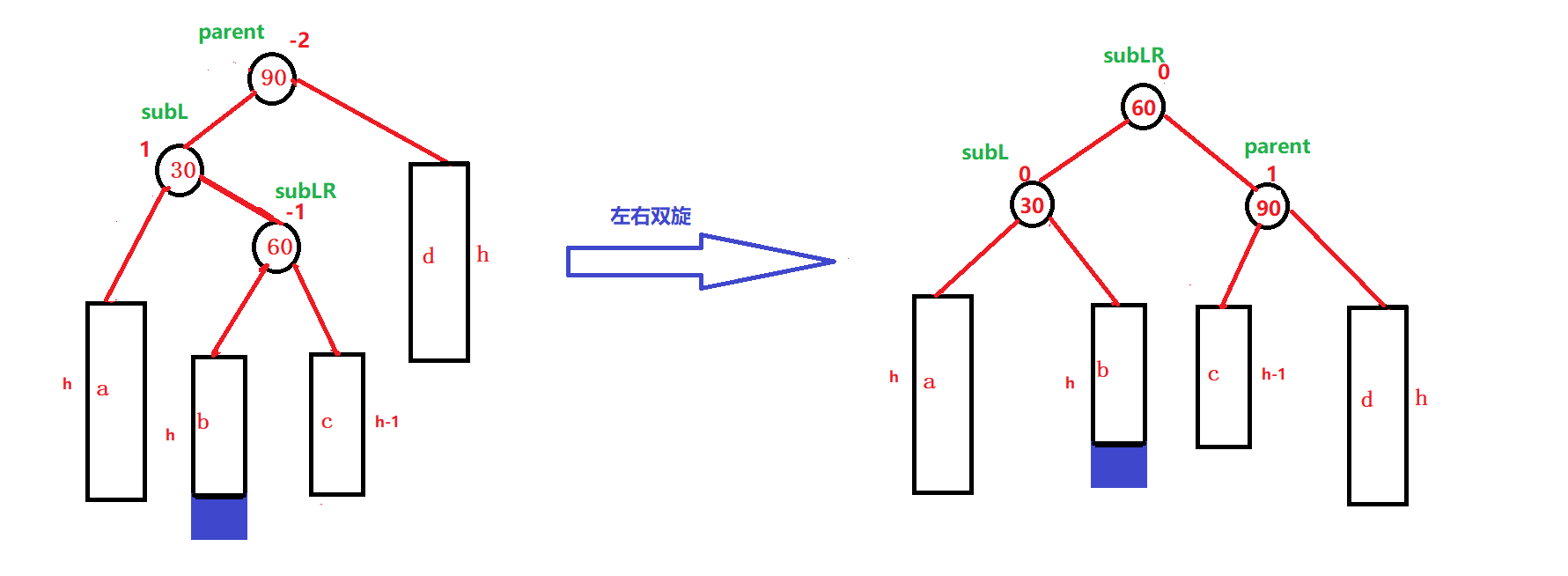
如果subLR的初始平衡因子是1时,左右双旋后parent、subL、subLR的平衡因子分别更新为0、-1、0(插入在c)
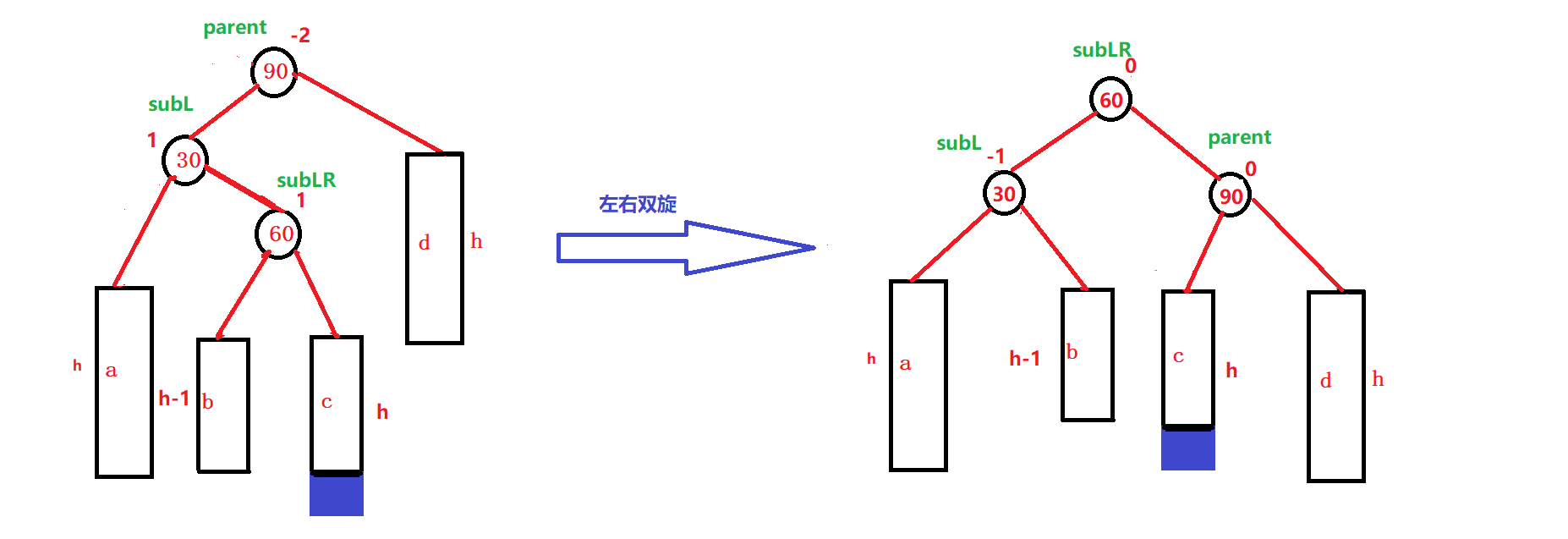
如果subLR初始平衡因子是0时,左右双旋后parent、subL、subLR的平衡因子分别更新为0、0、0(subLR自己新增)

代码实现:
//左右双旋void RotateLR(Node* parent){Node* subL = parent->_left;Node* subLR = subL->_right;int bf = subLR ->_bf;RotateL(parent->_left);RotateR(parent);//更新平衡因子if (bf == -1)//b插入,subLR左子树新增{subL->_bf = 0;parent->_bf = 1;subLR->_bf = 0;}else if (bf == 1)//c插入,subLR右子树新增{parent->_bf = 0;subL->_bf = -1;subLR->_bf = 0;}else if (bf == 0)//subLR自己新增加{parent->_bf = 0;subL->_bf = 0;subLR->_bf = 0;}else{assert(false);}}4.右左双旋
新节点插入较高右子树的左侧—右左:先右单旋再左单旋
插入
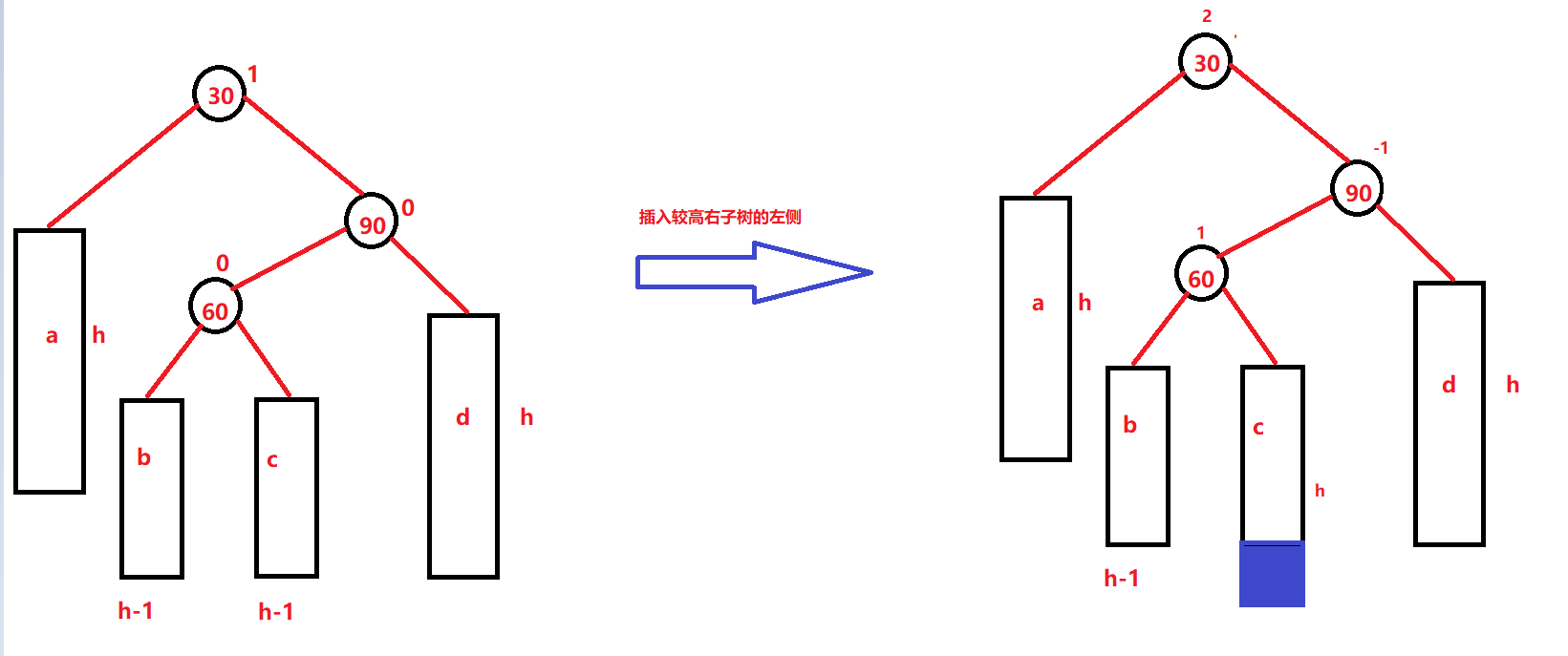
subR为轴点进行右单旋:
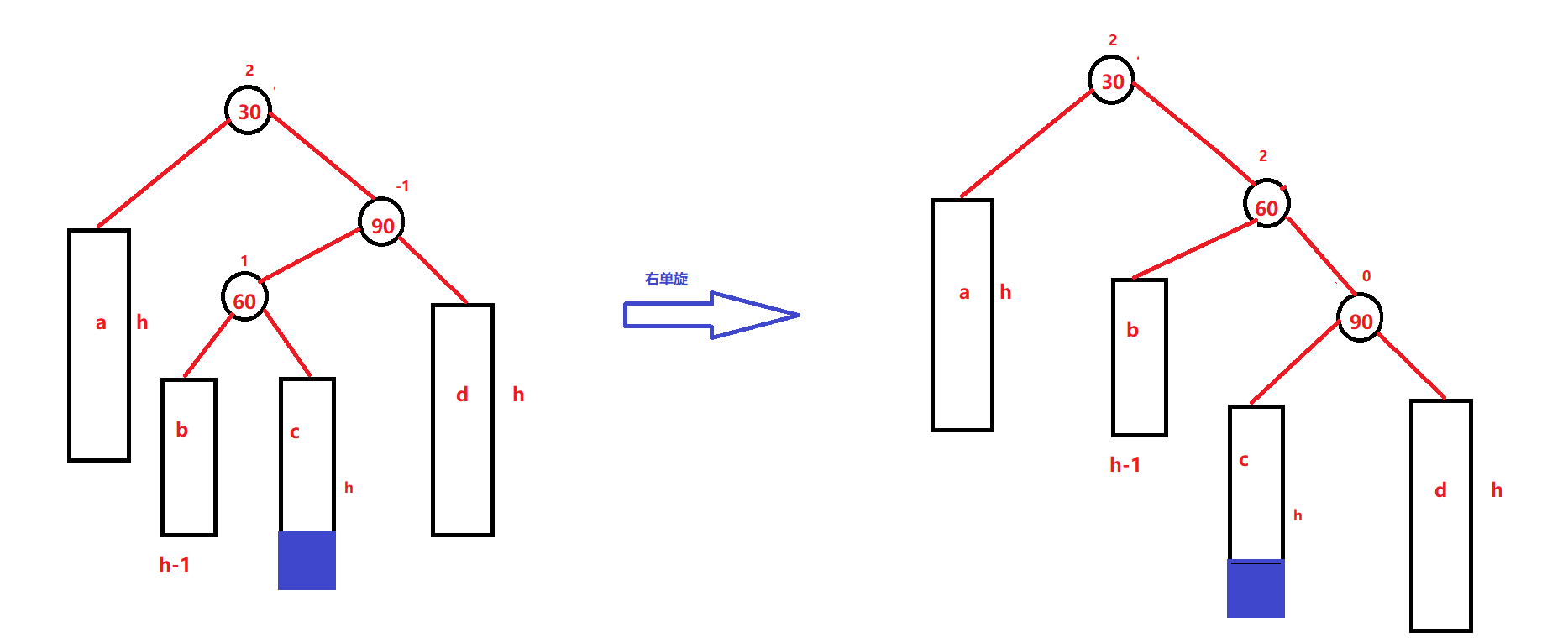
parent为轴进行左单旋:
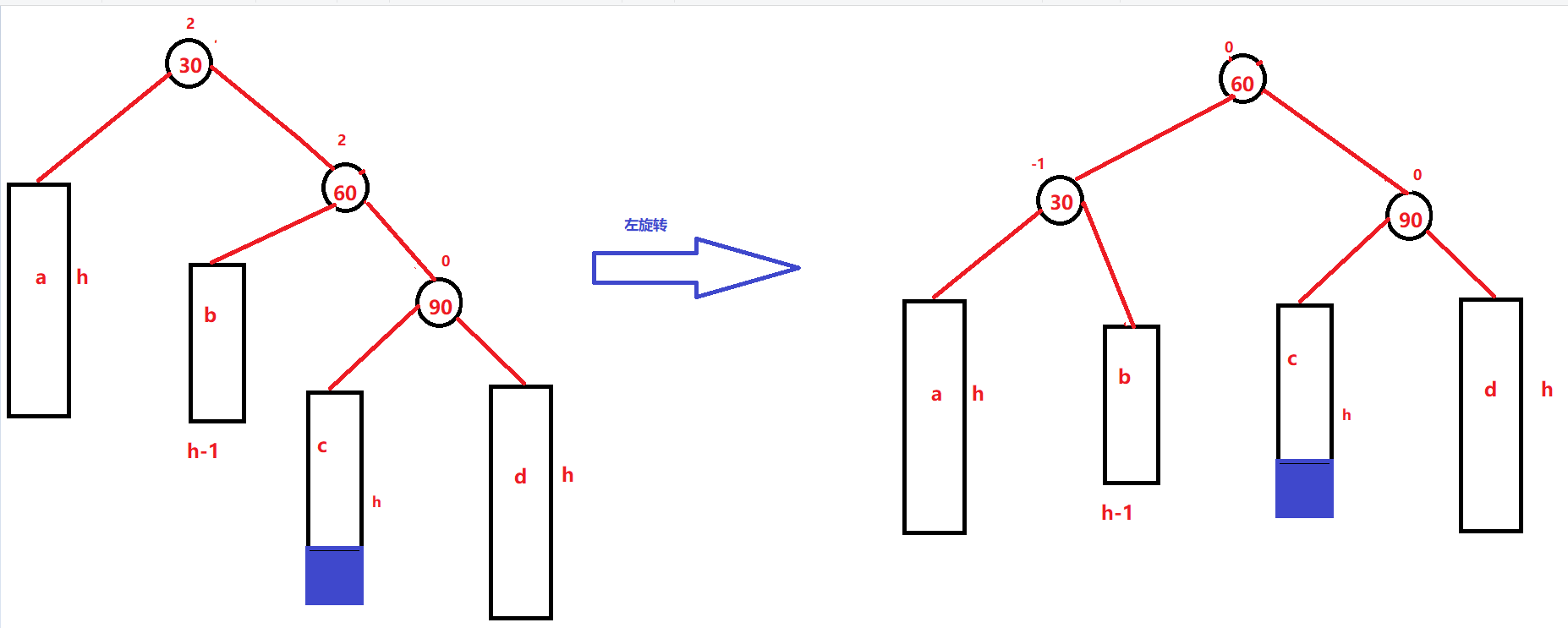
既右左双旋:
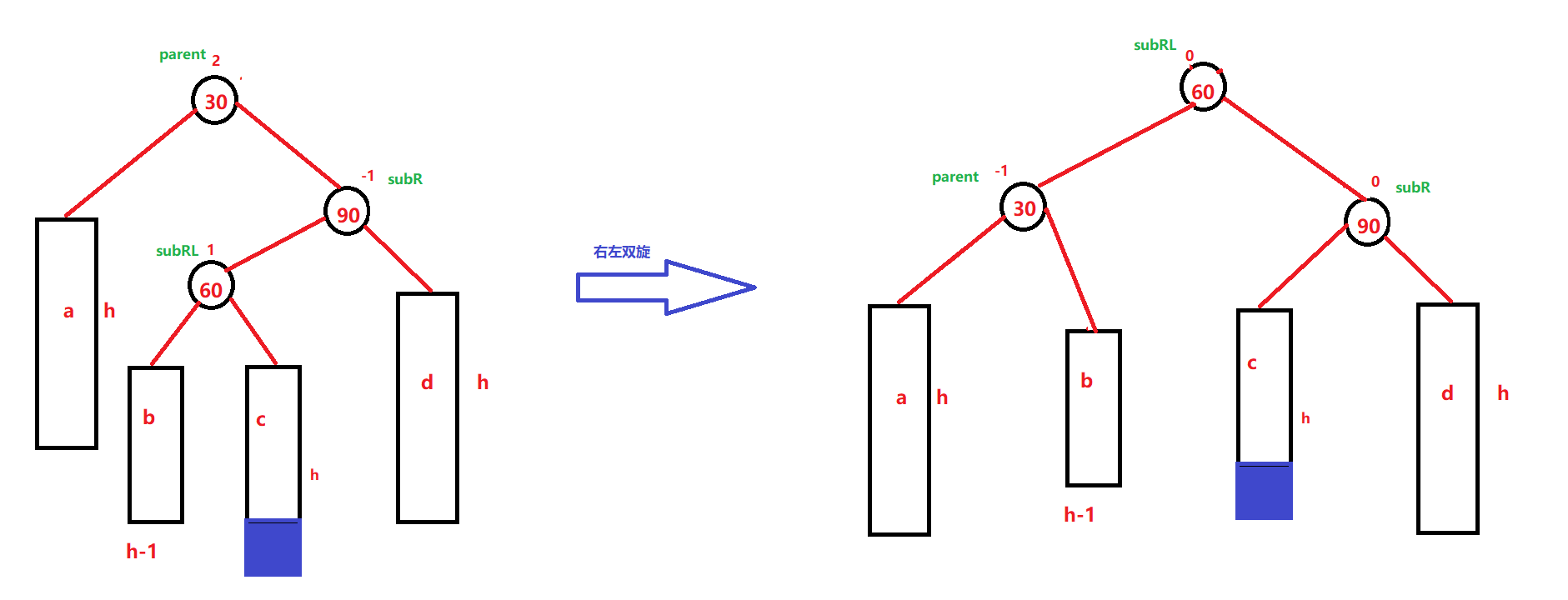
右左双旋后,根据subRL 初始平衡因子的不同分为三种情况分别对应subRL = 0、1、-1情况,与左右双旋情况类似。
void RotateRL(Node* parent){Node* subR = parent->_right;Node* subRL = subR->_left;int bf = subRL->_bf;RotateR(subR);RotateL(parent);if (bf == 1){subR->_bf = 0;subRL->_bf = 0;parent->_bf = -1;}else if (bf == -1){subR->_bf = 1;subRL->_bf = 0;parent->_bf = 0;}else if (bf == 0){subR->_bf = 0;subRL->_bf = 0;parent->_bf = 0;}else{assert(false);}}五、进行验证
AVL树是在二叉搜索树的基础上加入了平衡性的限制,因此要验证AVL树,可以分两步:
验证其为二叉搜索树
如果中序遍历可得到一个有序的序列,就说明为二叉搜索树
void _InOrder(Node* root){if (root == nullptr)return;_InOrder(root->_left);cout << root->_kv.first << ":" << root->_kv.second << endl;_InOrder(root->_right);}验证其为平衡树
每个节点子树高度差的绝对值不超过1(注意节点中如果没有平衡因子)节点的平衡因子是否计算正确
如果是空树,是AVL树;高度差不大于2,并且递归左右子树的高度差都不大于2,也是AVL树;判断平衡因子和该点的高度差是否相等
//求高度int Height(Node* root){if (root == nullptr)return 0;int lh = Height(root->_left);int rh = Height(root->_right);return lh > rh ? lh + 1 : rh + 1;}//判断平衡bool IsBalance(Node* root){if (root == nullptr){return true;}int leftHeight = Height(root->_left);int rightHeight = Height(root->_right);if (rightHeight - leftHeight != root->_bf){cout << root->_kv.first << "平衡因子异常" << endl;return false;}return abs(rightHeight - leftHeight) < 2&& IsBalance(root->_left)&& IsBalance(root->_right);}六、AVLTree的性能
AVL树是一棵绝对平衡的二叉搜索树,其要求每个节点的左右子树高度差的绝对值都不超过1,这样可以保证查询时高效的时间复杂度即log2( N) 。但是如果要对AVL树做一些结构修改的操作,性能非常低下,比如:插入时要维护其绝对平衡,旋转的次数比较多,更差的是在删除时,有可能一直要让旋转持续到根的位置。
因此:如果需要一种查询高效且有序的数据结构,而且数据的个数为静态的(即不会改变),可以考虑AVL树,但一个结构经常修改,就不太适合.
送上源码:
#pragma once#include <iostream>#include <assert.h>#include <time.h>using namespace std;template<class K,class V>struct AVLTreeNode{pair<K, V> _kv;AVLTreeNode<K, V>* _left;AVLTreeNode<K, V>* _right;AVLTreeNode<K, V>* _parent;int _bf;//balance factorAVLTreeNode(const pair<K,V>&kv):_kv(kv),_left(nullptr),_right(nullptr),_parent(nullptr),_bf(0){}};template <class K,class V>struct AVLTree{typedef AVLTreeNode<K, V> Node;public:bool Insert(const pair<K, V>& kv){if (_root == nullptr){_root = new Node(kv);return true;}Node* parent = nullptr;Node* cur = _root;while (cur){if (cur->_kv.first < kv.first){parent = cur;cur = cur->_right;}else if (cur->_kv.first > kv.first){parent = cur;cur = cur->_left;}else{return false;}}cur = new Node(kv);if (parent->_kv.first < kv.first){parent->_right = cur;cur->_parent = parent;}else{parent->_left = cur;cur->_parent = parent;}//更新平衡因子while (parent){if (cur == parent->_left){parent->_bf--;}else{parent->_bf++;}if (parent->_bf == 0){break;}else if (parent->_bf == 1 || parent->_bf == -1){cur = parent;parent = parent->_parent;}else if(parent->_bf==2||parent->_bf==-2){//左旋转if (parent->_bf == 2 && cur->_bf == 1){RotateL(parent);}//右旋else if (parent->_bf == -2 && cur->_bf == -1){RotateR(parent);}//左右双旋else if (parent-> _bf == -2&&cur->_bf==1){RotateLR(parent);}//右左双旋else if (parent->_bf ==2&&cur->_bf ==-1){RotateRL(parent);}else{assert(false);}break;}else{assert(false);}}return true;}//左单旋void RotateL(Node* parent){Node* subR = parent->_right;Node* subRL = subR->_left;parent->_right = subRL;if (subRL)subRL->_parent = parent;Node* ppNode = parent->_parent;subR->_left = parent;parent->_parent = subR;if (ppNode == nullptr){_root = subR;_root->_parent = nullptr;}else{if (ppNode->_left == parent){ppNode->_left = subR;}else{ppNode->_right = subR;}subR->_parent = ppNode;}parent->_bf = subR->_bf = 0;}void RotateR(Node* parent){Node* subL = parent->_left;Node* subLR = subL->_right;parent->_left = subLR;if (subLR)subLR->_parent = parent;Node* ppNode = parent->_parent;parent->_parent = subL;subL->_right = parent;//if(_root==parent)if (ppNode == nullptr){_root = subL;_root->_parent = nullptr;}else{if (ppNode->_left == parent){ppNode->_left = subL;}else{ppNode->_right = subL;}subL->_parent = ppNode;}subL->_bf = parent->_bf = 0;}//左右双旋void RotateLR(Node* parent){Node* subL = parent->_left;Node* subLR = subL->_right;int bf = subLR ->_bf;RotateL(parent->_left);RotateR(parent);//更新平衡因子if (bf == -1)//b插入,subLR左子树新增{subL->_bf = 0;parent->_bf = 1;subLR->_bf = 0;}else if (bf == 1)//c插入,subLR右子树新增{parent->_bf = 0;subL->_bf = -1;subLR->_bf = 0;}else if (bf == 0)//subLR自己新增加{parent->_bf = 0;subL->_bf = 0;subLR->_bf = 0;}else{assert(false);}}//右左双旋void RotateRL(Node* parent){Node* subR = parent->_right;Node* subRL = subR->_left;int bf = subRL->_bf;RotateR(subR);RotateL(parent);if (bf == 1){subR->_bf = 0;subRL->_bf = 0;parent->_bf = -1;}else if (bf == -1){subR->_bf = 1;subRL->_bf = 0;parent->_bf = 0;}else if (bf == 0){subR->_bf = 0;subRL->_bf = 0;parent->_bf = 0;}else{assert(false);}}void InOrder(){_InOrder(_root);}void _InOrder(Node* root){if (root == nullptr)return;_InOrder(root->_left);cout << root->_kv.first << ":" << root->_kv.second << endl;_InOrder(root->_right);}int Height(Node* root){if (root == nullptr)return 0;int lh = Height(root->_left);int rh = Height(root->_right);return lh > rh ? lh + 1 : rh + 1;}bool IsBalance(){return IsBalance(_root);}bool IsBalance(Node* root){if (root == nullptr){return true;}int leftHeight = Height(root->_left);int rightHeight = Height(root->_right);if (rightHeight - leftHeight != root->_bf){cout << root->_kv.first << "平衡因子异常" << endl;return false;}return abs(rightHeight - leftHeight) < 2&& IsBalance(root->_left)&& IsBalance(root->_right);}private:Node* _root = nullptr;};//测试void TestAVLTree(){//int a[] = { 8,3,1,10,6,4,7,14,13 };//int a[] = { 16, 3, 7, 11, 9, 26, 18, 14, 15 };int a[] = { 4,2,6,1,3,5,15,7,16,14 };AVLTree<int, int> t;for (auto e : a){t.Insert(make_pair(e,e));}t.InOrder();cout << t.IsBalance() << endl;}void TestAVLTree2(){srand(time(0));const size_t N = 100000;AVLTree<int, int> t;for (size_t i = 0; i < N; i++){size_t x = rand();t.Insert(make_pair(x, x));}//t.InOrder();cout << t.IsBalance() << endl;}以上就是关于“C++ AVLTree高度平衡的二叉搜索树怎么实现”这篇文章的内容,相信大家都有了一定的了解,希望小编分享的内容对大家有帮助,若想了解更多相关的知识内容,请关注编程网行业资讯频道。
免责声明:
① 本站未注明“稿件来源”的信息均来自网络整理。其文字、图片和音视频稿件的所属权归原作者所有。本站收集整理出于非商业性的教育和科研之目的,并不意味着本站赞同其观点或证实其内容的真实性。仅作为临时的测试数据,供内部测试之用。本站并未授权任何人以任何方式主动获取本站任何信息。
② 本站未注明“稿件来源”的临时测试数据将在测试完成后最终做删除处理。有问题或投稿请发送至: 邮箱/279061341@qq.com QQ/279061341














